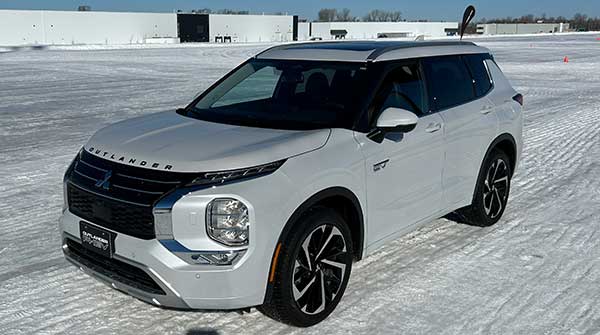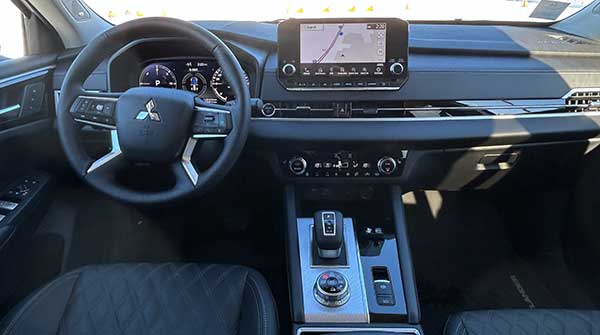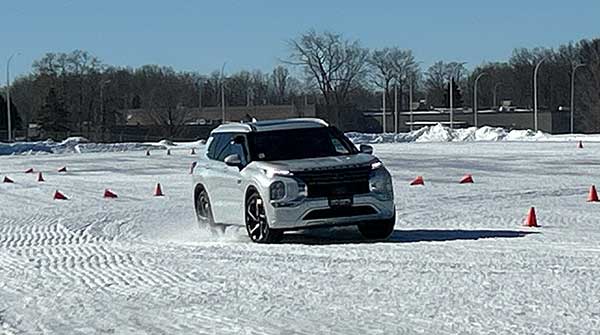
The Mitsubishi Outlander PHEV is stylish and luxurious – and is great on ice and snow.
Get behind the wheel of the Mitsubishi Outlander PHEV and discover its power and versatility
 The Mitsubishi Outlander PHEV is Canada’s best-selling plug-in hybrid electric sport utility vehicle. A total of 35,708 Outlander PHEVs were sold across Canada last year, an increase of 61.6 percent from the previous year.
The Mitsubishi Outlander PHEV is Canada’s best-selling plug-in hybrid electric sport utility vehicle. A total of 35,708 Outlander PHEVs were sold across Canada last year, an increase of 61.6 percent from the previous year.
The Outlander was introduced to the Canadian market in 2018, with a completely updated Outlander PHEV was introduced in 2023.
The newest version has three rows of seating and can accommodate seven people, while the previous version had just two rows of seats. The Outlander sits on a 2,706 mm (106.5 in) wheelbase and is 4,710 mm (185.4 in) long. That makes it slightly larger than the previous model, which had a wheelbase of 2,669.5 mm (105.1 in) and was 4,694 mm (184.8 in) long.
The latest version has also been substantially upgraded inside. It’s much more luxurious and elegant than the previous model. It’s also very spacious and quiet, making for a very comfortable and relaxing ride.
 The interior of the Outlander is elegant and luxurious, and controls and instruments are logical and easy to find. |
 Driving with S-AWC and then without shows the difference. |
| MORE HYBRIDS |
Prices start at $48,198 for the base ES, while the top-level GT Premium starts at $58,198. All trim levels have the same dimensions and power sources: a 2.4-litre four-cylinder engine producing 131 horsepower at 5000 rpm and twin AC synchronous permanent magnetic motors front and rear for a total output of 248 horsepower. Charging time for the 20 kWh lithium-ion battery is about 16 hours on a conventional 120-volt outlet, 6.5 hours on a 240-volt charger, and 38 minutes for an 80 percent charge on a quick charger. There is a 10-year or 160,000-km warranty on the powertrain and electric drive battery. The rest of the vehicle has a five-year or 100,000 km warranty.
Its estimated range in electric-only mode is 61 kilometres. Then the gas engine takes over, so there’s no range anxiety that is a concern with an electric-only vehicle. Mitsubishi says the Outlander has a total range of 687 km when the battery is fully charged and the gas tank is full. Estimated fuel consumption in gas-only mode is 9.2 litres per 100 km in the city and 9.0 on the highway. The combined gas and electric sources produce an estimated consumption of 3.6 litres equivalent per 100 km. It varies depending on how much driving is done in electric-only mode and how often the gas engine is used. Obviously, this vehicle would be ideal for those driving less than 61 kilometres at a time.
Like its competitors, the Outlander has traction control. A rotary knob on the console allows the driver to select the drive mode: power, eco, normal, tarmac, gravel, snow or mud.
All trim levels of the Outlander also have what Mitsubishi calls Super All Wheel Control (S-AWC), which does more than regular traction control. S-AWC also provides two additional benefits for consumers.
“If, for example, you’re driving across a bridge and there’s a strong crosswind and the car begins to sway from left to right, Super All-Wheel Control is operating to reduce the amount of sway and help to keep the car centred with the lane,” explains Steve Carter, director of marketing for Mitsubishi Motor Sales of Canada.
S-AWC also improves handling, even on dry pavement. “Say you’re pulling off the highway, and the off-ramp comes up a little quick, and you have to brake really hard to make the turn. Super All-Wheel Control will help with the braking so you can move through the corner more safely,” Carter adds.
Mitsubishi recently invited automotive journalists to the Montreal area to test drive the latest version of the Outlander PHEV, with Super All-Wheel Control, on ice and snow at ICAR Mirabel.
“This is an event where you can experience the Outlander in ways that you typically can’t experience when you’re driving the vehicle on the road,” says Carter. “We want to demonstrate how well the Outlander handles in the snow and ice.”
And there’s no doubt S-AWC makes a difference.
I first practiced it in snow mode, swerving between pylons and then doing a wide circle. After a few runs, I switched to normal mode, did the same circuit at the same speed, and found there was plenty of sliding. I had to slow down significantly to maintain control. With no other traffic around, the slipping and sliding didn’t pose a threat. Only a few plastic orange pylons were knocked over. But it was clear what a significant difference S-AWC makes.
Dale Johnson is an award-winning author, broadcaster and journalist who has worked in TV, radio, print and online. While the manufacturer provided Dale with a vehicle to test drive, the content of this review was not reviewed or accepted by the manufacturer.
For interview requests, click here.
The opinions expressed by our columnists and contributors are theirs alone and do not inherently or expressly reflect the views of our publication.
© Troy Media
Troy Media is an editorial content provider to media outlets and its own hosted community news outlets across Canada.
